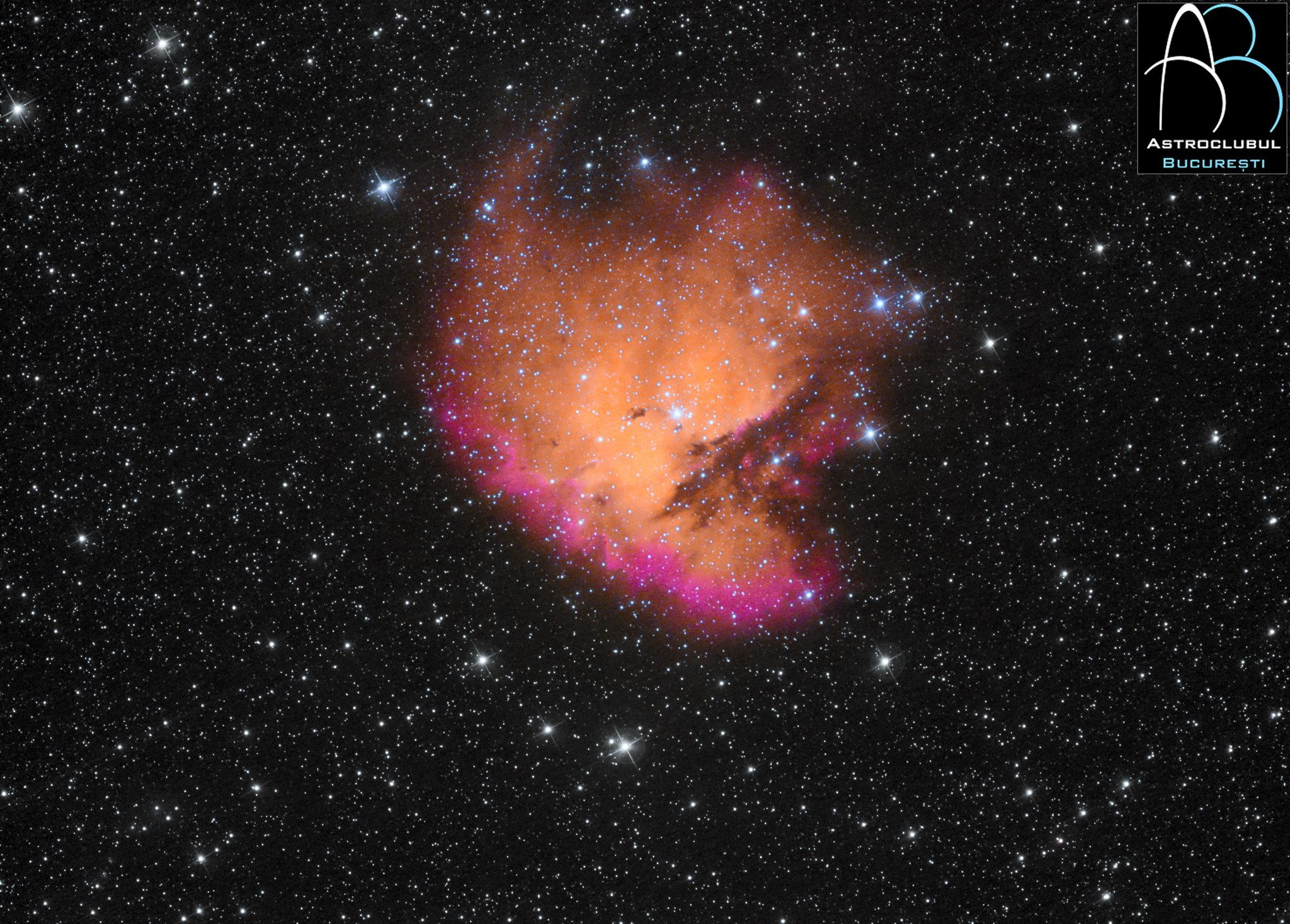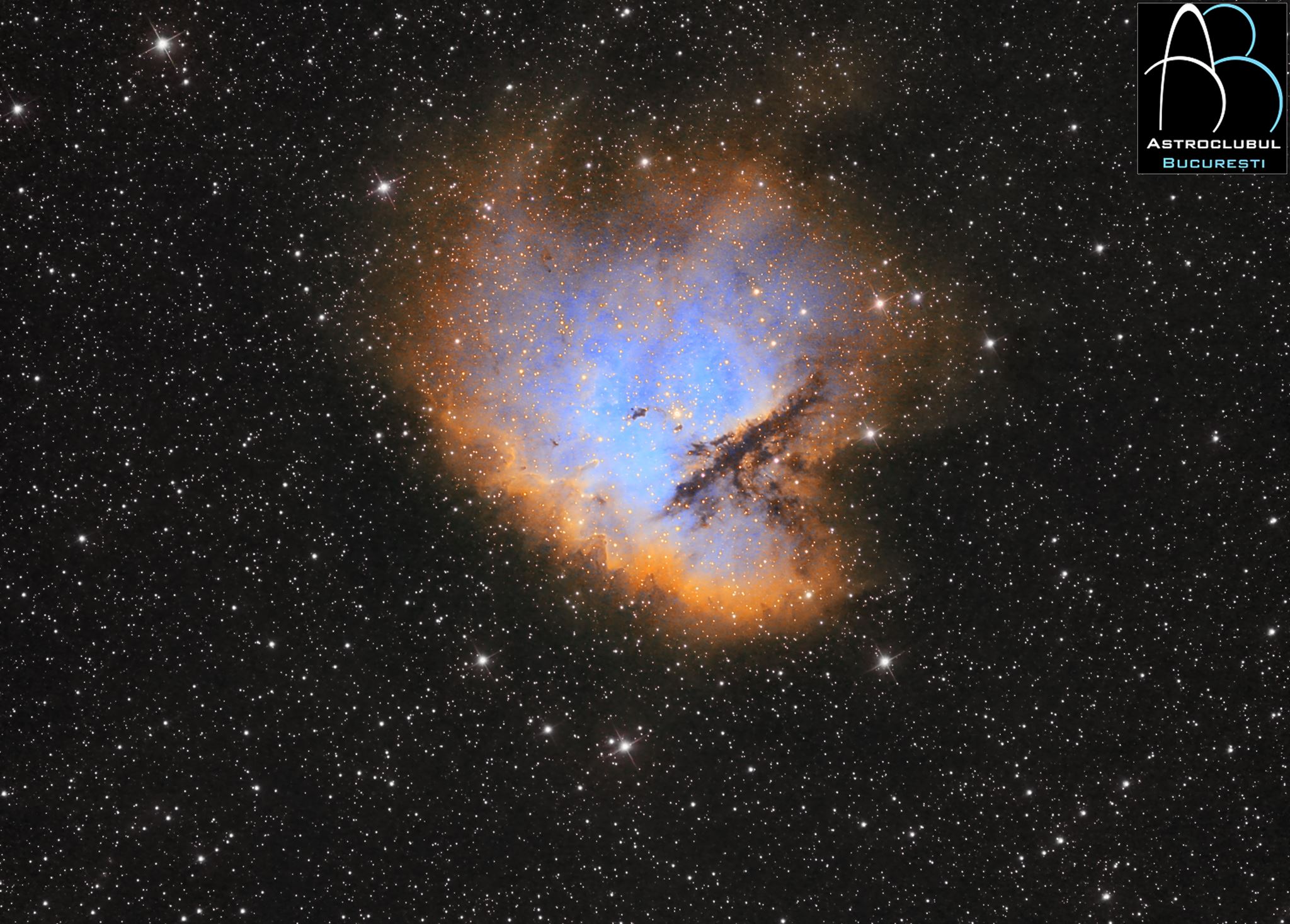Report
Pacman Nebula by Prof. Daniel Bertesteanu, Bucharest Astroclub, Romania
Dec 19
2018
At 9,200 light years from us, in the Perseus arm of our Galaxy, there is NGC 281,
an emission nebulae that can be seen in the direction of the constellation
Cassiopeia. Due to the likeness of a character in some video games, it is also known as
the Pacman Nebula. Inside, a group of young blue and super hot stars clusters are forming
the open-swarm named IC 1590. The intense pressure and radiation ionizing the entire nebula, "sculpting" and
spreading the gas and dust near it, to the periphery until to 40 light-years away,
is forming radial columns and compact masses of gas and dust known as
“Bok globules” that can be easily seen in our image. Within these globules there are intense stars formation processes and
protoplanetary systems. The photo was shot in “narrow band” by means of three selective filters that
allowed only the frequencies of the light generated by NGC 281 to pass
through the various chemical elements in its composition and the temperatures
in which they are in the nebula. Ionized hydrogen atoms, sulfur and nitrogen are emiting strong in red and the oxygen
is emitting in green, at aprox. 500nm. Due to the abundance of hydrogen in the nebula, intense red emissions of 656.28 nm are
predominant and are corresponding to the Balmer alpha transitions of hydrogen. These real colors are later distributed during the processing in red (R), green (G),
and blue (B) imagery so as to produce a tricolor image in a false color palette
because the resulting colors do not match those of the atoms they generated its. In narrow band astrofotography there are two, well known colors assignments
in RGB channels: - in the Hubble palette for which the master images obtained through the Sulfur (S),
Hydrogen (H), and Oxygen (O) filters are attributed to the R, G and B channels.
The resulting colors are false because both the sulfur and hydrogen alpha filters
let only red to pass.
However, for a more dynamic and more contrast aspect, hydrogen is attributed
to the green channel and oxygen to the blue one. Due to the abundance of hydrogen, the images resulting from the combination
tend to be excessively green and the stars tend to be colored in violet. Later on, during processing, the green color is fading resulting in a modified
Hubble palette dominated by blue and yellow. - In the Canadian France Haway Telescope (CFHT) palette of the R, G and B channels
are assigned to the master images obtained through the H, O and S filters. In this case, the resulting color is somewhat closer to reality because the hydrogen
is put into the channel red and oxygen to green. However, the sulfur emissions
are put into the blue channel which does not correspond to the reality
because they are more red than those of hydrogen alpha. The resulting image from this color palette is dominated by pink-red (hydrogen)
and yellow (oxygen). The pictures were made in three nights through 6 nm HOS filters with a telescope
130/650 mm equiped with a QHY 163 monochrome camera, cooled down to -20 °C,
totaling 12 hours of integration time and processed in the Hubble palette
and CFHT colors. Author: Prof. Daniel Bertesteanu, Bucharest, Romania,
Member of Astroclubul Bucuresti
(Bucharest Astroclub, Romania)
- Very nice work! Greetings to the guys in Romania. Look forward to seeing what you do for outreach this year.
You need to be logged in to leave a comment
About Me
Astroclubul Bucuresti is an amateur astronomer association in Romania. The association is continuing the tradition of amateur astronomy in Romania, which started in 1907 with the founding of the first “Romanian Astronomical Society". We are amateur astronomers mainly from Bucharest but we also have members in Melbourne (Australia), Auckland (New Zeeland), Cambridge (UK), Paris (France), Silistra (Bulgaria), Canary Islands (Spain). The main interests of our organization are visual observations, astrophotography, variable star observations, spectroscopy, outreach in schools and popularizing astronomy to the general public and organizing lectures and astronomy training courses. Astroclubul Bucuresti also regularly cooperates with the Astronomical Institute...
Contact
| Location: | Bucharest, Romania Romania  |
|---|---|
| Website: | www.astroclubul.ro |
| Social Media: |








 UAE Astronomy Group
UAE Astronomy Group
Comments